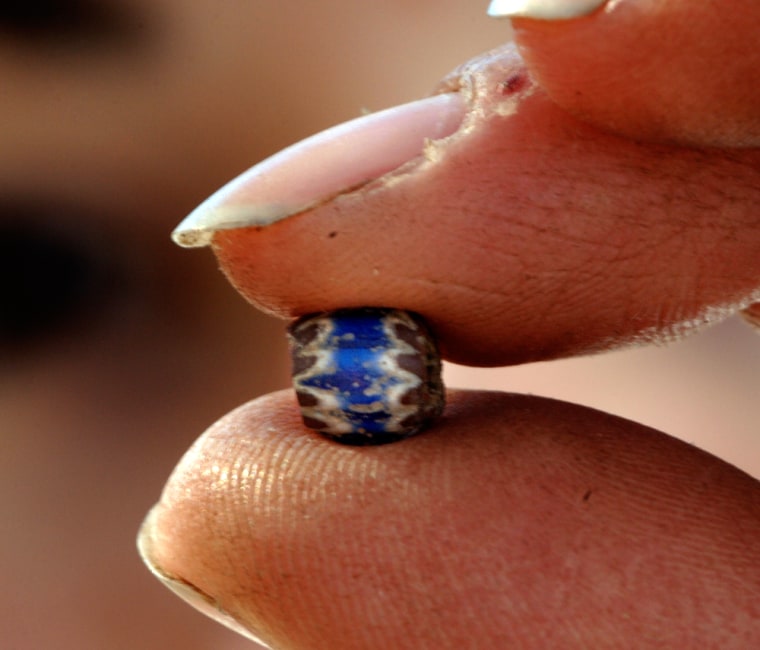A rusty, diamond-shaped iron blade, its sharp point jutting from the dirt where it was discovered, could be a centuries-old clue that sheds new light on the obscure path taken by the Spanish explorer Hernando de Soto.
For archaeologist Dennis Blanton it has erased most doubts that the patch of ground in southeast Georgia was visited more than 460 years ago by some group of Spanish explorers — if not by de Soto himself.
“It’s pretty much ‘case closed,’” says Blanton, standing in a clearing among planted pines where his archaeologists have dug about 18 inches (46 centimeters) into the dirt in an area the size of a small house. “If you had to deduce the most plausible source, it would be de Soto.”
But it also presents a mystery: The site is 90 miles (144 kilometers) from where experts believe de Soto traveled. It highlights the challenge of deducing the route taken by de Soto, an explorer who left few traces of his journey.
Hernando de Soto became the first European to explore the interior of present-day Georgia in 1540, when he and 600 men arrived nearly two centuries before the British founded the colony of Georgia in 1733.
Historians and archaeologists have long debated his exact path, which took him through much of the South. Few Spanish artifacts along his trail have been found. Blanton says, cautiously, his findings in rural Telfair County may provide some physical proof of de Soto’s presence.
‘A fog of doubt’
Blanton of the Fernbank Museum of Natural History in Atlanta has been digging on-and-off for 18 months on private land used for growing pine trees in rural Telfair County, about 120 miles (190 kilometers) west of Savannah.
Along with shards of Indian pottery, Blanton’s team has uncovered two scraps of iron and five ornate, pea-sized glass beads. Blanton says he’s convinced the beads and iron were brought by Spanish explorers to trade with Indians.
However, the site where Blanton’s team found its artifacts near the Ocmulgee River lies about 90 miles southeast of where most experts believe de Soto crossed the river near Macon. The few known written accounts by de Soto’s companions are short on landmarks other than rivers and long-vanished Indian villages.
Archaeologist Charles Hudson spent a decade dogging de Soto’s trail. The route he and two colleagues first published in 1984 remains the map of de Soto’s course most accepted by experts. But Hudson says it’s a pursuit fraught with uncertainty.
“They weren’t modern men and weren’t self-consciously trying to leave an account of where they went,” said Hudson, a retired University of Georgia archaeologist. “It’s kind of maddening, because everything is enclosed in a fog of doubt.”
Beads tell a story
In the summer of 2006, Blanton began digging in hopes of finding a remote Spanish mission established in the 1600s. Instead, he found beads that experts agree were fashioned a century earlier by Italian glassmakers. Italy was known to trade the beads with the Spanish, who brought them across the ocean.

Historians agree de Soto and his men entered present-day Georgia near its southwest corner and worked their way northeast into South Carolina on the first leg of a winding trek that took de Soto 4,000 miles (6,400 kilometers) from northern Florida to Arkansas, where he died of fever in 1542.
In 1984, Hudson and fellow researchers Marvin T. Smith and Chester DePratter published a route for de Soto’s Georgia travels that had him crossing the Ocmulgee River near Macon.
Hudson and his colleagues mapped de Soto’s route using written accounts of three men traveling with the explorer and matching them with geographic features and archaeological evidence of Indian settlements they believed the explorer encountered. Hudson said what made his proposed route stand up to scrutiny was that the Indian sites formed a chain across the state.
“If you just pinpoint a single location on the basis of artifacts, the evidence is not very strong — and these are all portable artifacts,” Hudson said. “I’m a little dubious that de Soto was down that far.”
Did Indians trade their treasures?
Smith, an anthropologist at Valdosta State University, said the most likely scenario would be that the Spanish artifacts found in Telfair County got there by way of Indians trading among themselves.
“It would be so easy for the Indians to move that stuff around among themselves,” Smith said. “It was so shiny and new and something they’d never seen before.”
Blanton argues that archaeologists typically find Spanish iron and beads in Indian graves, indicating that Indians prized such rare and alien trinkets. The Telfair County artifacts, however, appear to have been found on the floor of a home.
Blanton argues Indians would have treasured glass beads and iron too much to leave them discarded on the ground, but Spaniards wouldn’t have valued them as much.
Regardless of de Soto’s involvement, experts agree the Telfair County site offers a rare window to a distant history when Indian cultures thousands of years old first collided with Europeans intent on conquering the new world.
“Everything changed instantly,” Blanton said, “as soon as those Spaniards emerged from the woods and came up the riverbank.”
